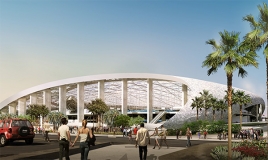“For us, as we rebrand, put new uniforms on, and make this stadium our own, the growth of this stadium will parallel the growth of our organization and the brand as well,” Demoff said. “And our fans will play a great role in that.”
Los Angeles Rams New Stadium in Inglewood Begins to Take Shape

What a difference a year makes.
This time last year, the Rams’ new stadium in Inglewood was nothing more than a large pile of dirt in the ground. But with the start of a new year came a lot of new progress — specifically, the completion of the excavation stage at the Los Angeles Sports and Entertainment District at Hollywood Park.
“We’re keeping pace with where we should be on the schedule,” said Robert Aylesworth, the Vice President of AECOM Hunt Construction Group. “Most of our milestones are structural and right now it’s kind of a race to the top.”
Ground broke on construction over 14 months ago. Now, as Aylesworth said, the skeleton of the stadium — the structural retaining wall surrounding the seating bowl and the beginnings of a roof — is beginning to take shape.
And the enormous 300-acre site is finally “coming alive.”
“I think the amazing thing is every time you come on site you’re amazed by something new,” Rams Chief Operating Officer Kevin Demoff said. “Every time you come on site there’s a new detail that you start to see.
From here now you can start to see the field take shape, and I just sit here and think what that could look like when we run out of that tunnel to host a game for the Rams here.”
The construction of the shared site is expected to be completed in time for the 2020 NFL season, when it will begin hosting home games for the Rams and Chargers. And while the site is unprecedented in its magnitude, the details of the architectural design are also extremely impressive.
Over six million cubic yards of dirt have been excavated to date, 45,000 cubic yards of concrete have been poured, 15,000 tons of steel are being installed, and 850 workers per day are being employed.
All of this hard work will result in a 70,000-seat open-air stadium, a 6,000-seat performance venue, and plans for hundreds of retail and office spaces — all of which will be designed in a way that is unique to Los Angeles.
“I think at the end, what we’re looking to do is take the ultimate luxury and combine it with the highest level of experience and convenience,” said Greg Kish, the VP of Sales and Service for LASED. “The fans in L.A, rightfully so, have a perception and definitely big expectations for their entertainment venues and we’re hoping to deliver on that.”
“When you’re standing, you’ll look across the lake and say, ‘That building looks like it could only be built in Los Angeles,’” Demoff added. “And I think that was Stan Kroenke’s vision — something that was an international, global, iconic venue.”
The new stadium will also be unique to HKS — the design firm behind Kroenke’s vision. HKS Architects is responsible for many iconic sports venues across the United States, including AT&T Stadium in Dallas and U.S. Bank Stadium in Minnesota.
But the LASED project will mark a series of firsts for the firm.
“What separates this project is it’s the first of its kind that really is bringing the sports and entertainment district together,” Demoff said. “And really the world’s preeminent stadium — the largest stadium ever built when you talk about square footage, 3.1 million square feet.”
“The first indoor-outdoor stadium to ever be constructed,” he added, “so really a clear roof to protect fans from the elements, but also open air on all sides. There are no walls on the building, so you’ll feel like you’re sitting in an open-air stadium.”
Starting in 2020, fans will be able to experience the stadium in all of its glory. The venue will be used for year-round events and will host the Super Bowl LVI, 2023 College Football National Championship, and the 2028 Summer Olympic Games.
And most exciting of all for Rams fans, the venue will provide a home base for Los Angeles football for many years to come.






